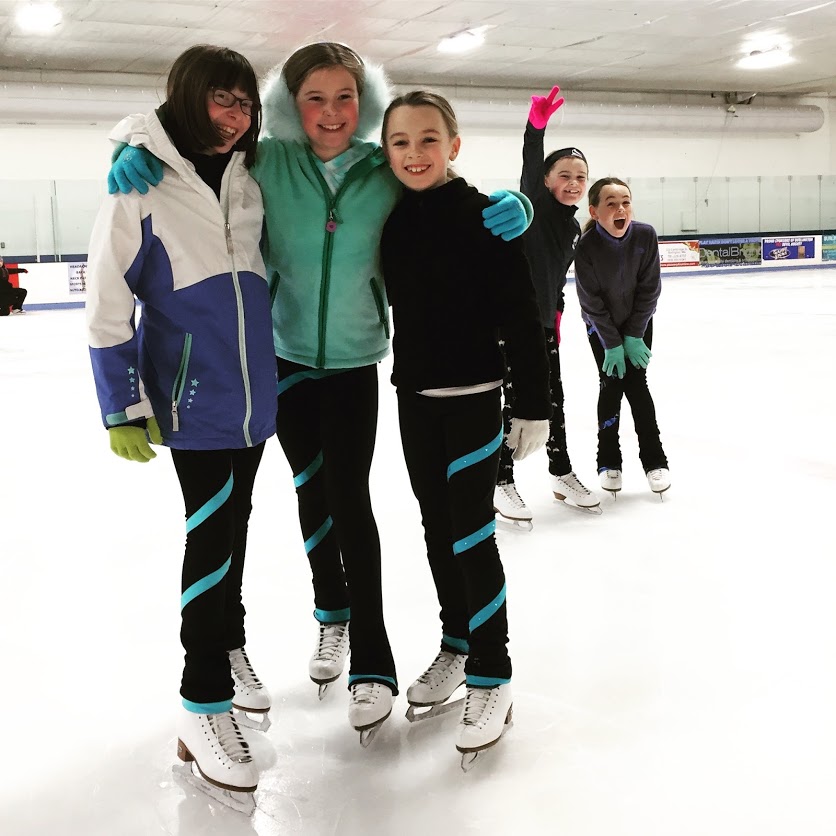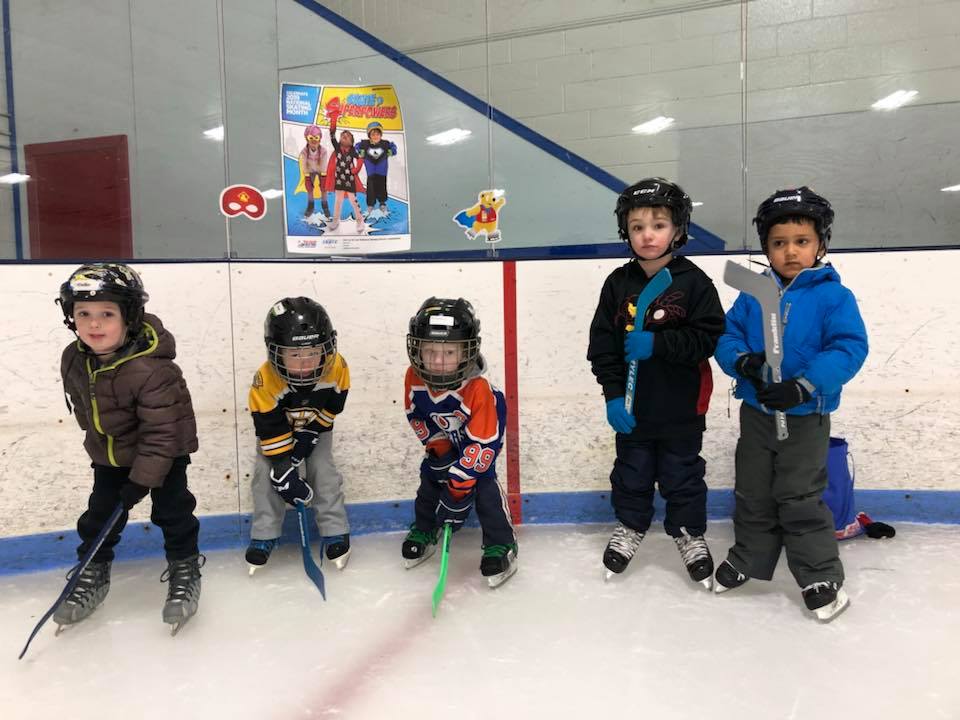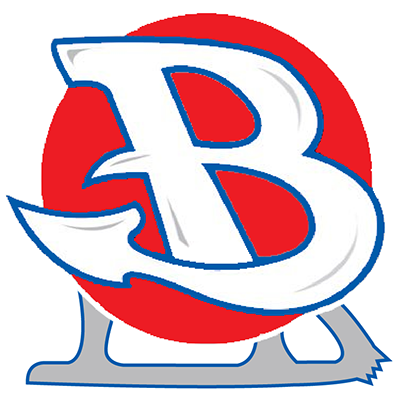What Should My Skater Wear?

It may seem obvious, but the ice rink is cold! Layers are ideal for newer and younger skaters. Long pants and sleeves are critical, even if the weather outside is warm. A winter coat or a sweatshirt (maybe even with the Burlington Skating logo on it?), depending on the weather and your child’s level of comfort, are important. Some new skaters do well to wear a pair of snow pants, both for the extra warmth and a little cushioning for when they inevitably fall down. Don’t forget gloves or mittens, those little fingers get awfully chilly! Scarves are not ideal for skating lessons, as they can dangle and get in the way.
Helmets are required for all skaters through level Basic 3. A bicycle helmet is fine, or if you have a hockey or skiing helmet, those work as well. If a skater wishes to wear a hat or ear warmer, it should not interfere with the fit of the helmet. Additional pads (knee, elbow, etc) are not necessary and can sometimes hinder range of motion for new skaters.
Good socks are another important item! While you may think that thicker socks are inherently better for warmth, ones that are too thick will negatively impact the fit of the skate and make it harder for your skater to balance or be in control. Normal athletic socks are fine, best if they are mid-calf-length or longer. Shorter ankle or “no-show” socks that kids often wear with sneakers can be uncomfortable under skates, since the seam of the sock can be pressed into the ankle by the boot of the skate. Ideally the socks would come up higher than the top of the skate. Older skaters who are skating a little harder and generating more heat will often wear thinner tights or knee-high nylons.
What Skates Should My Skater Wear?
For new skaters, especially our youngest skaters, we strongly recommend starting with figure skates, even if the child’s ultimate goal is to play hockey. The boot and blade of figure skates are easier for many young skaters to learn to balance and begin stroking skills. Once they feel comfortable on the ice, it is generally an easy transition to hockey skates for those who prefer them.
Used skates can be a good option for new skaters and quickly-growing feet. Many of our families have accumulated quite a stash of skates over the years, so we have created a private Facebook Buy/Sell group for ease of connecting local families. Other good sources to consider might be Play it Again Sports, Craigslist, or even Ebay. Quality and selection may, of course, vary quite a bit.
New skates can be purchased online at a variety of websites. For instance, Riedell Sparkle or Soar skates are available on Amazon and are a good choice for young children, available as small as a Toddler size 9. With all online ordering, sizing and returns can sometimes be hit or miss.
Our favorite local source for skates is Cooke’s Skate Supply in Wilmington. While you might find some cheaper skates online, the personal service at Cooke’s is excellent. They will get your skater in the appropriate skate for their level, and can usually stretch or mold the skates at no additional cost for a great fit. For the best service, call ahead and make an appointment to get your skates.
No matter where you get your skates, make sure to have the blades sharpened before you get onto the ice! Cooke’s offers skate sharpening, as does the manager at the Ice Palace. It typically costs between $10 and $25 to have skates sharpened, depending on the style and complexity of the blade.
Skate Guards
It is important to protect your skates, especially the blades! Skate guards are critical. Soft, absorbent cloth guards (sometimes called “soakers”) are best for storing skates between lessons. They protect your blades from rust, while also preventing the sharp edges from scratching surfaces or poking holes in bags. They are low cost and available in a wide variety of colors. Some of them practically look like stuffed animals! Soft guards are not, however, appropriate for walking around in your skates. They can be slippery on hard floors, and are not durable enough to stand up to blades with weight on them.
Hard guards are best for when skaters have put their skates on but have not yet gotten on the ice. They are typically made of plastic or rubber. They help keep the blade nice and sharp, not dulling it from walking on wood or (gasp!) cement, as well as protecting the floor surfaces from scratches. They’re also great for breaking in new skates! Put those hard guards on and walk around the house for 10 minutes a day and they’ll be comfy in no time. Hard guards are not ideal for storing skates after a lesson, however, as the material does not absorb any remaining moisture and the blades can rust. These guards are inexpensive, adjustable, and easy to use.
When Can My Skater Start Playing Hockey?

We typically recommend that new skaters stay in our Learn-to-Skate program through level Basic 2 before moving over to BHSA’s Junior Devils program. This ensures they have a solid set of foundational skating skills and are ready to learn more about hockey and join their first team.
What About Private Lessons?
Please visit our Private Lessons page for more information on how to get started working directly with a coach!
What Comes Next?
Once a figure skater reaches some of the middle and upper Free Skate levels, they (or their parents) may wonder: what comes next? After several years of progressing through the Basic and Free Skate levels, what happens after Free Skate 6?
There are, of course, many options. Different skaters have different interests and goals! Those who wish to remain mostly recreational may simply choose to continue with Burlington Skating Graduate group lessons, and nothing more. That’s great, and we welcome all levels of skill and interest!
Most of our skaters, at this point, are already skating regularly with a private coach and are likely members of a Figure Skating Club. The next step for advanced skaters is beginning to take the official US Figure Skating Tests.
These tests are quite different from our more casual progression from one Learn-to-Skate level to another. While there are clear guidelines set by USFSA for each level, the determination of when a skater has passed a level is up to our local coaches. With USFS Testing, the requirements and standards are clearly set by the national organization. Test sessions are hosted at specific times by different Figure Skating Clubs, and whether a skater passes a test is decided by a panel of judges whom they do not know. Every test a skater passes is recorded as part of their USFSA membership, and that achievement is theirs forever, no matter where they skate!
Skaters’ first test will always be Pre-Preliminary Moves in the Field. “Pre-Preliminary” refers to the level (the first level in USFS Tests), and “Moves in the Field,” or MITF, refers to the category of test (MITF focuses on footwork, edges, stroking, etc.; no jumps or spins).
Individual skaters also work on Free Skate tests, which are solo programs that include different jumps and spins. Skaters must pass the equivalent level of MITF before they can take each Free Skate test. (For instance, they must pass Pre-Preliminary MITF before they take Pre-Preliminary Free Skate.)
There are other categories of USFS Tests for Pairs skating and Ice Dance. For more information on test requirements and sequences, consult the USFSA website and talk to your coach! As always, every skater progresses at their own pace. The most important part is that you continue to enjoy our sport!
Testing can seem pretty confusing if it’s new to you. Don’t be afraid to ask your skater’s coach, or the parents of more seasoned skaters, to help explain it to you! We’ve all been there.
